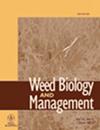研究糙米草、水稻残留物覆盖和出苗后除草剂对未水稻插秧杂草生长和产量的影响
IF 1.5
4区 农林科学
Q3 AGRONOMY
引用次数: 0
摘要
杂草是雨季未灌浆移栽水稻的主要威胁。为了综合利用芝麻渣绿色地膜、稻草地膜和出苗后除草剂来管理杂草,2017 年和 2018 年雨季期间,在瓦拉纳西进行了一项分小区试验。试验在主地块采用了三种地膜覆盖处理,即无地膜覆盖(NM)、在行间采用芝麻覆盖作物及其绿色残留物地膜覆盖(SRGM)和水稻秸秆地膜覆盖(RRM),以及五种杂草管理处理,即杂草丛生、人工除草两次(HWT)、出苗后施用双草醚 25 g a. i ha-1(BP)、施用水稻秸秆地膜覆盖(RRM)和施用除草剂。i ha-1 (BP)、五氟磺草胺 30 g a.i ha-1 (PX)、双嘧磺草胺 25 g a.i ha-1 + 吡唑嘧磺隆 20 g a.i ha-1 (BP + PS)。与杂草丛生条件下的 NM 相比,SRGM 和 RRM 成功地降低了禾本科杂草(包括 Echinochloa colona 和莎草)的密度和生物量以及杂草总生物量(59% 和 49%)。事实证明,地膜覆盖与出苗后除草剂相结合,不仅能减少杂草,还能提高产量。本文章由计算机程序翻译,如有差异,请以英文原文为准。
Studies on Sesbania, rice residue mulching and post emergence herbicides on weed growth and yield in unpuddled transplanted hybrid rice
Weeds are a major threat in unpuddled transplanted rice during rainy seasons. To manage weeds by using Sesbania residue green mulch, rice straw mulch and post emergence herbicides in an integrated way, an experiment was conducted in a split plot at Varanasi during the rainy season of 2017 and 2018. The experiment was taken with three mulching treatments in main plots, namely, no mulching (NM), cover crop of Sesbania aculeatea followed by its green residue mulch (SRGM) and rice straw mulch (RRM) in inter rows and five weed management treatments, namely, weedy, hand weeding twice (HWT), post emergence application of bispyribac 25 g a.i ha−1 (BP), penoxsulam 30 g a.i ha−1 (PX), bispyribac 25 g a.i ha−1 + pyrazosulfuron 20 g a.i ha−1 (BP + PS) in subplots replicated thrice. SRGM and RRM were noted to be successful in reducing density and biomass of grasses including Echinochloa colona and sedges and total weed (59% and 49%) biomass compared to NM under weedy conditions. Mulching, integrated with post emergence herbicides proved its potency in not only weed reduction but is also in yield enhancement.
求助全文
通过发布文献求助,成功后即可免费获取论文全文。
去求助
来源期刊

Weed Biology and Management
农林科学-农艺学
CiteScore
2.70
自引率
0.00%
发文量
13
审稿时长
>36 weeks
期刊介绍:
Weed Biology and Management is an international journal, published four times per year. The journal accepts contributions in the form of original research and review articles in all aspects of weed science. Contributions from weed scientists in the Asia–Pacific region are particularly welcomed.
The content of the contributions may relate to weed taxonomy, ecology and physiology, weed management and control methodologies, herbicide behaviors in plants, soils and environment, utilization of weeds and other aspects of weed science. All contributions must be of sufficient quality to extend our knowledge in weed science.
 求助内容:
求助内容: 应助结果提醒方式:
应助结果提醒方式:


